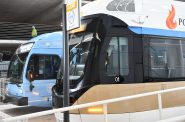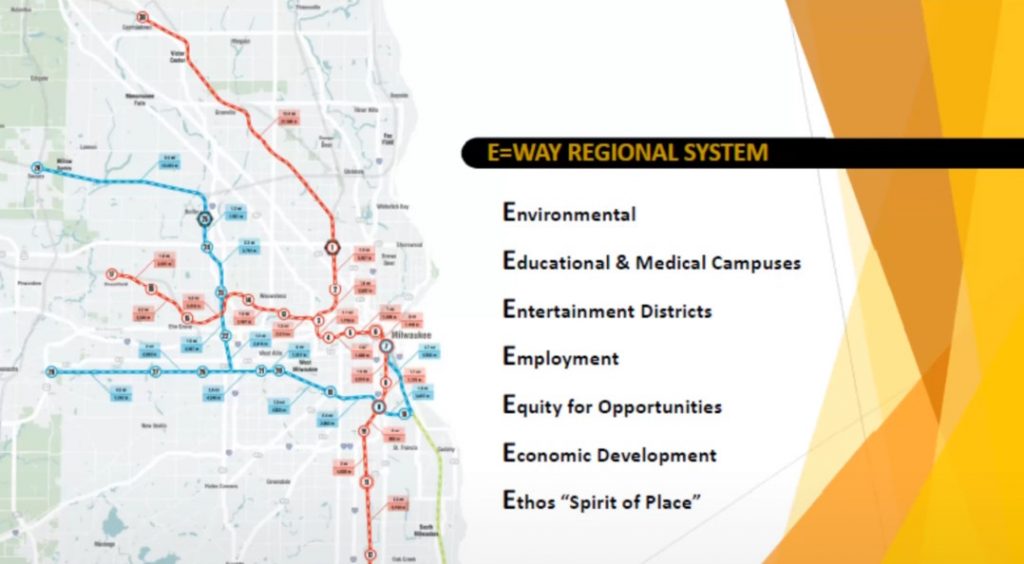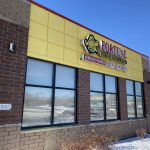Commuter Rail Startup Has Big Vision, Lots of Questions
Regional system, say organizers, would use existing tracks, require no operating subsidy.
The E=Way, a proposed private commuter rail system, seems practical on its face. Create a regional commuter rail system for Milwaukee using existing freight rail tracks, develop stations at vacant sites and fund the system with upfront grants and revenue from associated real estate development.
But actually advancing the plan is proving to be a slow process. And many questions remain, including securing up-front funding and if the system would actually be self sustaining. There is also the question of how interested the freight railroads are.
Transit Innovations, the company proposing the system, believes it has a winner.
“We did have an eureka moment early in our planning, when we realized that unique to Milwaukee and this region, we realized the railroad’s existing rail system already connects every trip generator in the region that sells tickets along the E=Way commuter rail system,” said Jaqulynn Honl, Transit Innovations COO, in presenting the plan to the Rotary Club of Milwaukee on July 30.
The plan calls for 32 stations on multiple lines spread over 100 miles of track in Milwaukee, Waukesha, Racine, Kenosha and Washington counties. An initial five-stop line, according to the system website, would run from Century City to the Milwaukee Airport Rail Station. Honl, during her presentation, said the system is also exploring a Milwaukee to Waukesha County startup line.
Honl said Transit Innovations, led by Brian Kliesmet, has been working on the idea for more than a decade.
“The goal of Transit Innovations is to connect our key economic assets via a modern, regional public transit system. For the past 12 years this startup company has invested the necessary due diligence to move this project forward on many levels. Many people ask ‘why has it taken you so long? Why has it taken 12 years?’ Well you can imagine what it would take to build a railroad system for the region.”
Honl said the group has secured a $400 million private activity bond that would be backed by Citigroup. She said, at the advice of the railroads, they are also pursuing federal capital support. The system is expected to cost more than $1 billion to construction.
“We are now leveraging private funding with public investment to ensure the success of this project,” said Honl. “The key to success is a profitable business model with sustainable operations without subsidization.” She said the E=Way will be financially sustainable because it involves leasing existing freight rail track and developing stations on brownfield sites. The company said Honl, would be operationally sustained by ticket sales, parking revenue, last-mile connector revenue and advertising “without a need for operational subsidies.”
An essential component of the plan is what happens next to the stations.
“But the E=Way is not just a transit system,” said Honl. It includes $500 million of transit-oriented, mixed-use development around stations. “In short, this is an economic development project.”
An affiliate of the company, Transit Oriented Development LLC, is already pursuing a 35-unit condo complex in West Allis near a potential station location. The company is also pursuing a hotel on a vacant lot across from Milwaukee Intermodal Station.
Honl said the company is exploring demand estimates for existing job centers, 14 of which she said would be served by the route. “We are currently working on an updated job creation study that is being performed by Baker Tilly and being graciously funded by First Ring Industrial Enterprise,” said Honl. Other ideas being floated include using surface parking lots at American Family Field as part of a co-located station.
“Transit Innovations sees a vision of what a clean, efficient and safe public transit system could be,” said Honl.
She said the company was raising funding to buy station sites, finalizing agreements with the railroads and finalizing ridership and revenue studies for partnerships with municipalities.
“When will the E=Way launch? It’s a question that is difficult to answer,” said Honl.
The first phases would rely on 66 miles of Canadian Pacific Kansas City (CPKC) track and 35 miles of Union Pacific (UP) track. Future extensions could involve an additional 29 miles of Union Pacific track. Freight trains would continue to operate on the track. Honl said the railroads have “actively participated” in the system’s development, provided guidance on seeking federal funding and would entertain discussions about track leasing when stations were solidified.
The largest involved railroad, however, says that’s not an accurate assessment. “We have not had conversations with this group,” a CPKC spokesperson told Urban Milwaukee.
Shortly after publication, a UP spokesperson told Urban Milwaukee: “Transit Innovations has approached Union Pacific about a potential partnership, but there are no commitments nor agreements in place at this time.”
Honl, during her presentation, said Transit Innovations is requesting non-disclosure agreements be signed to see its 240-page business plan, station sites and more information on its “many conversations” with the railroads.
“We continue to invest in the research to build a modern business model for a profitable and sustainable privately funded commuter rail system,” said Honl.
It must also continue to refine its travel time estimates. Trip lengths shown in the E=Way presentation are impressively short. Most notably, a trip from Milwaukee Intermodal Station to the Milwaukee Airport Rail Station, an existing 7.1-mile route that the Amtrak Hiawatha makes in 15 minutes without stops, would take 10 minutes and involve extra stops at new stations. A future 35.6-mile line from Intermodal Station to Pleasant Praire would take an estimated 21 minutes, with stops, according to the presentation. In response to a question from the audience, Honl said the estimate is trains would average 30 to 40 miles per hour between stations. “I’m going to work on those calculations with our team,” she said.
There is also a question of what trains to use. A conceptual rendering, designed by The KPA Group, of a station in the 30th Street corridor shows a high-speed Talgo-branded train. However, no U.S. commuter rail system uses such equipment; instead, higher-capacity equipment suited for frequent stops is typically deployed. Talgo, however, could benefit from the system’s role in moving workers, as it continues to rehabilitate commuter rail cars from California near a proposed station in the Century City business park.
Municipalities, according to Honl, have not been asked to provide direct financial support. “The greatest participation from each municipality is support,” said the COO. Mayor Cavalier Johnson provided a letter of support in October 2022. “I am supportive of the private sector efforts underway by Transit Innovations & Transit Oriented Development to reestablish commuter rail in the Milwaukee area,” says the five-paragraph letter, obtained by Urban Milwaukee. The City of Milwaukee, as part of the 2018 Komatsu South Harbor Campus, acquired a purchase option for a potential Harbor District station that any future operator could take advantage of.
Honl said the company would soon release an investment deck to solicit funding to acquire the station sites.
There are few models to look at as a guide to what Transit Innovations is proposing. Brightline, a private intercity rail operator in Florida created by Milwaukee Bucks owner Wesley Edens, launched in 2018 and relies heavily on real estate development. But the system functions as a longer-distance inter-city rail line instead of suburban commuter rail. It also had an unusual and advantageous development environment when Edens’ Fortress Investment Group purchased the underlying freight railroad and its extensive landholdings in 2007 for $3.5 billion. The line, which operates between Miami and Orlando, has yet to turn a profit.
Two Other Proposals Moving Forward
Two other commuter rail proposals are also on the drawing board for Milwaukee.
A revived governmental push, led by Racine Mayor Cory Mason, is seeking to see the Kenosha-Racine-Milwaukee (KRM) commuter rail system developed. Substantial planning work for the system was done in the 2000s, but the system and its transit authority funding structure were a casualty of state politics in the 2011 state budget cycle. The proposal would use a Union Pacific line through the southern suburbs that follows the Lake Michigan shore. The existing Amtrak Hiawatha Service line uses an inland CPKC line and makes fewer stops than the planned commuter rail line.
Racine secured a $5 million federal planning grant in 2022 to support KRM development. Potential funding sources, including transit-oriented development near stations, are to be examined in the grant-backed study.
A second private group, Wisconsin Transit & Realty Group (WTR), is pursuing a private commuter rail system in the same KRM corridor. The Wisconsin Department of Transportation (WisDOT) sponsored a Federal Transit Administration New Starts grant request for the system in 2022, but, according to WisDOT Chief of Railroads and Harbors Lisa Stern, withdrew its support because of a lack of a local funding source to access the grant.
WTR and WisDOT did not respond to a request for comment by the time of publication. Transit Innovations’ Kliesmet was previously a partner with Michael Garven of WTR on an earlier effort.
The KRM proposal would involve linking up with the Chicago-area Metra system at the station on the edge of downtown Kenosha. The corridor is not included in the initial lines to be developed by Transit Innovations.
If you think stories like this are important, become a member of Urban Milwaukee and help support real, independent journalism. Plus you get some cool added benefits.
Transportation
-
Congestion Pricing Cuts Air Pollution in New York City
 Dec 14th, 2025 by Jeff Wood
Dec 14th, 2025 by Jeff Wood
-
FTA Tells Milwaukee to Crack Down on Fare Evasion — Even Where Fares Don’t Exist
 Dec 12th, 2025 by Graham Kilmer
Dec 12th, 2025 by Graham Kilmer
-
Will GOGO’s Bus Service Ever Get Going?
 Dec 9th, 2025 by Jeramey Jannene
Dec 9th, 2025 by Jeramey Jannene






















I had to double check, but it was back in 2018 that Transit Innovations and WTR were both promoting their plans. One of them even speculated that an airport-to-downtown link could be up and running by the 2020 DNC in Milwaukee. (RIP) Transit oriented development remains exciting. Apparently, using existing track precludes placing stations where tracks cross. At those locations, perhaps one is elevated over the other. Too bad, those would hypothetically make great transfer stations, obviously.
I’m a huge proponent of “Make no little plans” and both of these remain exciting. And, you don’t see ol’ Franklin Furter trying to launch anything like this. That said, what is the likelihood of this actually happening? Is this a brilliant plan simply in need of funding? Or, is it far fetched? I dunno.
However, I have recently started putting the Iron District/USL Championship soccer team expansion in the same league as these plans. There is the chicken-and-egg process around getting funding for league expansion in MKE and building a facility vs. getting an expansion team approved by the league. The right Google news search yields many stories about other cities with stalled expansion plans. And, both USL and MLS are defendants in an antitrust suit filed by another league, claiming they conspired to carve up the US market.
Somewhere down the road, I may put Neutral’s plans for the Marcus Center’s parking garage in this same category. Relatively new and inexperienced developer with big ideas, but I believe only one completed project with a couple dozen residential units outside Madison. A couple more in development, not including The Edison. A $700 million project with 750 residential units that would start by building ~200,000 square feet of commercial space when everyone else in MKE/the country is bearish on commercial RE these days?
My wish is that each of these projects become smashing successes. We will see…
This plan sounds suspiciously similar to the B-Line plan from back in 2015 and is linked in the article; it even has some of the same people. The B-Line effort appeared at the same time the streetcar funding was being debated, and then nothing has been heard about it in the 9 years since until now. What’s happening now that this was resurrected? Is it because there’s federal money available for rail expansion?
I like the idea, but with big questions still open including whether the railroads will actually share the tracks and how sustainable funding will be secured, I question if this will happen. Plus, to make sense, the system needs to expand into the WOW counties and they have historically been hostile to any kind of rail transit.
What’s old is new again. Over 100 years ago, real estate developers got together and built trolley lines from city centers out to vacant land to promote development.
Some suggestions & observations –
Emphasize & design for RAPID rail transit!
Integrate this system with Milwaukee County’s buses by making each station a transfer point. Provide seamless or at least smooth fare purchase/collection between them.
Don’t cater to the Hop system. It’s just money and mobility potential mired in traffic and strangled by small platforms.
High-capacity cars should be used for economics and a smaller land footprint where other land uses already exist or may become important.
Sharing right-of-way with freight trains requires higher track and signal maintenance/inspection standards. Even freight trains themselves require monitoring for shifted loads and broken, protruding load-securing metal banding, supports etc.
I used to rent across the street from a rail line and would call these situations in to the railroad. This was especially important since down the line a man-on-the-ground inspection point was on a tight outside curve where such hazards appeared with only short time to react.
Insurance may be higher on routes that carry more hazardous
or oversized loads.
“There are few models to look at as a guide”
This is Big City Stuff – do it right – seek and evaluate outside info/advice/successful examples. While this is neither subway nor elevated, like them it is a widespread interaction of 2 different transit modes Hire experienced, seasoned, designers, managers and workers. Seek comments from rail commuters in other cities.
Build to withstand new extremes of weather.
Build for expansion or you will be building for Milwaukee’s decline. Milwaukee wants to grow, but without a wisely designed and built rapid transit system, we’ll just have more people getting in each other’s way.
Milwaukee has already squandered 3 major rail transit opportunities. First (1962) was the former North Shore right-of-way – downtown Milwaukee into the downtown Chicago Loop. We severed the Milwaukee Road ‘Beer Line’, (’90s) which ran from the Northwest side INTO an excellent potetial commuter station building in northern downtown. But the MOST STUPID was severing the Chicago and Northwestern, which was the only continuous south-side-to-north-side potential rapid rail right-of-way IN THE ENTIRE EASTERN HALF OF THE CITY!
Discrepancies in claims of cooperation/ communication with railroads –
Its possible that railroads’ interest in this project is mainly the government subsidies for right-of-way and revenue from track leasing. Railroads have been on a scrimping binge, even where safety is concerned. Get everything in writing, and evaluated by experts.